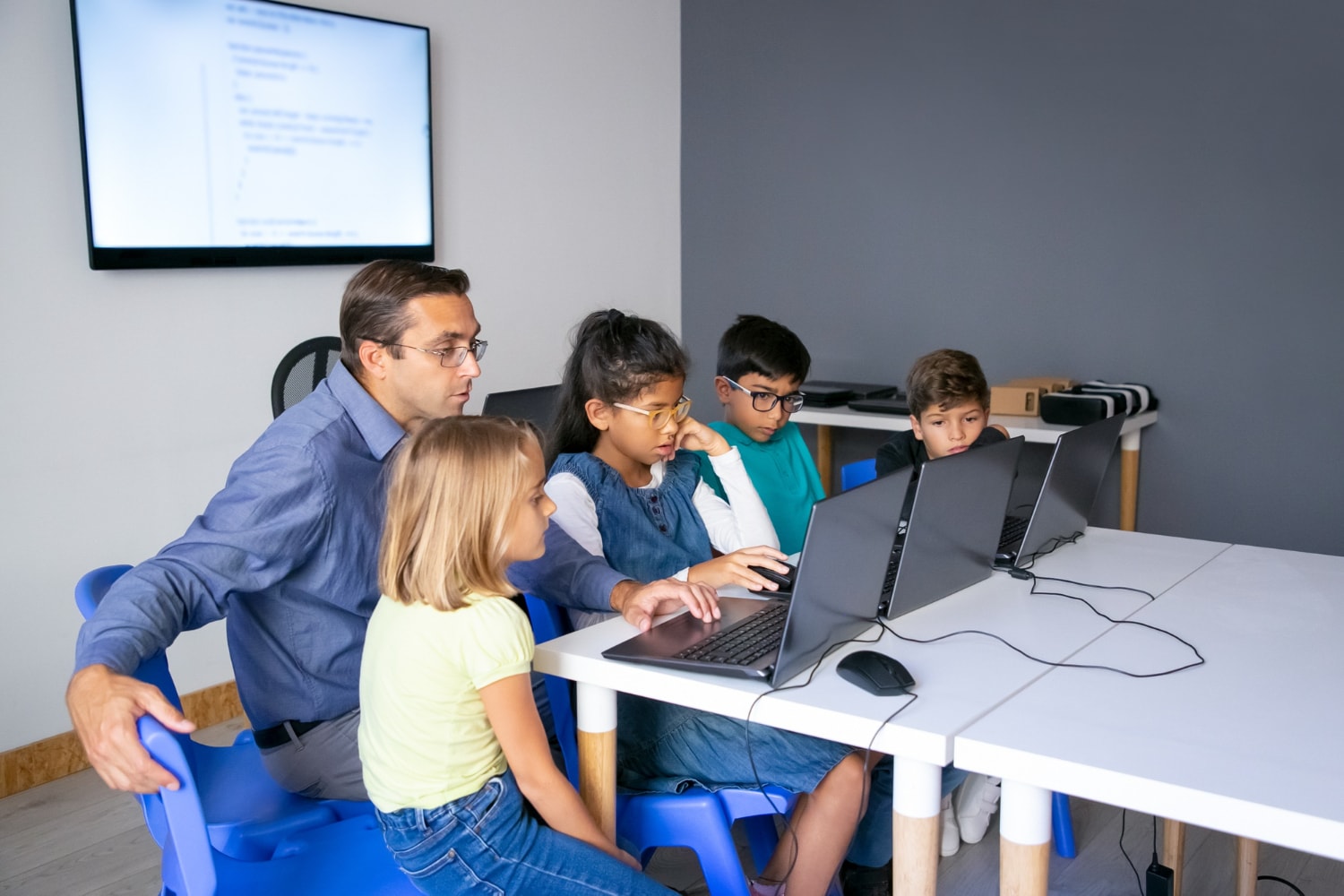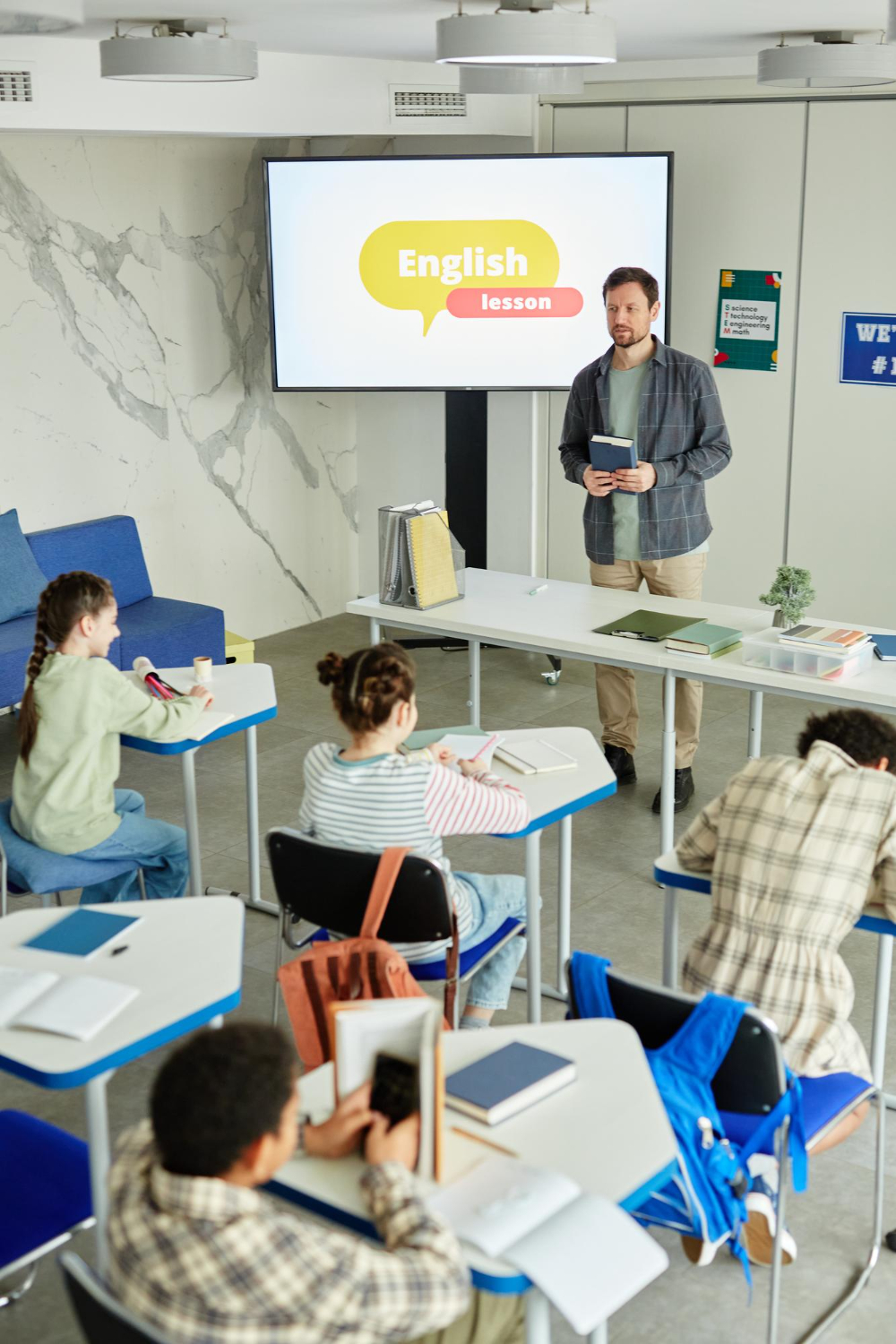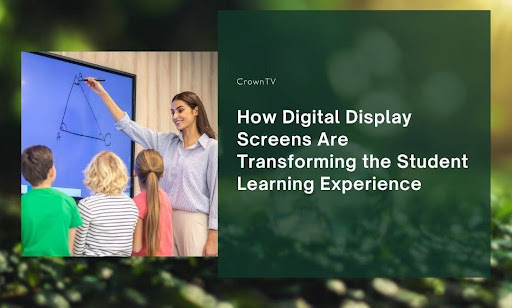Screens used to be distractions. Now they drive focus. Chalkboards faded. Projectors glitched. And flat PowerPoint slides? They couldn’t keep up. But in 2025, something’s shifted—and classrooms feel different. Students stay locked in. Teachers move quicker. Concepts stick better.
The biggest reason? Digital display screens aren’t passive anymore. They work harder than ever—pulling up content, breaking lessons down, and bringing information across in ways textbooks can’t touch.
Let’s call this what it is: a full shift in how learning feels. And it’s not limited to big universities or fancy tech labs. Every type of school is starting to set learning up around digital signage.
Here’s what this article will cover:
- How digital displays are changing classroom dynamics—not in theory, but in how students engage and teachers deliver
- The shift from static boards to interactive screens and what it looks like in a modern classroom
- Content flexibility—how teachers pull different media into a single lesson without losing attention
- Ways digital signage drives student participation with visuals that pull questions out instead of talking over students
- How CrownTV makes screen management scalable, simple, and secure—even when multiple locations or admin levels are involved
By the end, you won’t be wondering if screens belong in education. You’ll be figuring out how to get the most out of them.
What Screen-Based Learning Actually Looks Like in 2025
Classroom dynamics aren’t built around whiteboards anymore. They revolve around screens that pull the room in, not push information out. Students aren’t passively absorbing lessons from one angle. They’re reacting to motion graphics, responding to quizzes that pop up on screen, and watching lesson material shift based on group feedback. It keeps the pace fast but grounded.
The visual impact matters. When a display shows a clear diagram, animated process, or topic summary, it strips away confusion. Students don’t have to guess what’s important. It’s highlighted. It’s moving. It’s locked into place on screen, giving teachers the freedom to move around and guide rather than repeat themselves from a podium.
Teachers aren’t stuck in front of a projector anymore. They bring the screen up to emphasize key points, switch layouts in seconds, and mix formats in one lesson—charts, videos, live annotations, and even news updates.
This flexibility doesn’t just save time. It keeps engagement high. Short attention spans don’t have room to drift when content shifts visually every few minutes. Instead of asking students to picture how a process works, instructors now pull the concept up onscreen—animated, labeled, and timed to the moment it’s being discussed. That immediacy shortens the distance between question and understanding.
Screens Change The Pacing
They speed up lessons without rushing them. They cut the drag out of transitions, let teachers respond to questions on the fly, and reduce downtime during technical hiccups.
Classroom engagement doesn’t happen by accident anymore. It’s built into the layout, the tools, and the way content flows from the screen into students’ attention spans. That’s where the shift in 2025 really shows up—not in the tech specs, but in how classrooms move.
From Wall Boards to Interactive Screens That Shape the Lesson

The blackboard held on for decades. Projectors followed. Then came smartboards, with touch features that looked promising but didn’t fully take hold. By 2025, that gap finally closed.
Today’s interactive screens do more than display. They respond to input, integrate with lesson plans, and bring up multiple media types at once, without lag or rewiring. Schools made the switch not because it looked impressive, but because it solved daily friction.
In practical terms, here’s how the shift plays out:
- Teachers prepare lessons with drag-and-drop content blocks instead of formatting slides
- Displays switch between instruction, participation, and review modes—on command
- Live polls, attendance tracking, and timed quizzes run through the same screen
- Students tap, write, or gesture directly on digital signage displays in collaborative exercises
- Teachers pull up a student’s work, highlight it in front of the class, and annotate live
That’s not theory. That’s how The University of Missouri–St. Louis implemented touch-interactive displays in active learning classrooms. The outcome? Student participation increased by 67%, according to their Teaching and Learning Center. Faculty cited more flexibility in pacing, more collaboration, and less lecture fatigue.
This shift didn’t happen all at once. Most institutions started by replacing static whiteboards with interactive flat panels. Once those panels were connected to shared content platforms, teachers stopped wasting time setting up tech. Everything synced. Content stayed up to date. Lesson flow picked up.
There’s no reset between topics anymore. Educators swap formats on the spot—without shifting rooms or changing devices. Students stay focused because the lesson doesn’t stall. Screens become the center of instruction without becoming a crutch.
This isn’t a trend for big universities only. High schools and charter networks are picking up the tech and putting it to work. When teachers control the content and the display, classrooms stay tight, interactive, and on track. And once that switch happens, static boards stop making sense.
How Teachers Keep Lessons Tight Using Mixed Media
Attention doesn’t drift because students get bored. It drifts when lessons fall out of rhythm. And in 2025, teachers have tools to keep that rhythm steady by pulling different media types into one streamlined screen experience.
Forget juggling tabs, devices, or clunky transitions. Modern classroom digital school signs let educators bring everything together—in one sequence, on one screen, without delay—while supporting diverse learning styles and minimizing distractions.
Mixing Media Without Breaking Focus
Here’s how today’s educators pull content in without breaking the lesson up:
- Video clips are queued mid-lesson without buffering or screen swaps
- Charts and infographics are pinned beside live annotations for context
- Audio explanations are dropped in between visuals to reinforce a concept
- Interactive polls appear between lecture blocks to reset attention spans
- Short readings or slide decks are broken into timed screen sections—no clicks needed
This flow isn’t built on chance. It’s powered by digital tools that connect lesson structure to actual attention patterns, especially when educational games, interactive simulations, and multimedia presentations are lined up behind the scenes.
Why This Works in 2025 Classrooms?
Students expect lessons to move like media feeds—quick, visual, and uninterrupted. That doesn’t mean teachers speed things up. It means they line the content up in a way that feels natural.
Each format does a different job:
- Videos simplify complex concepts
- Graphics hold structure
- Text breaks things down line by line
- Quizzes snap attention back when focus starts to fade
This structure works especially well for diverse learners. By blending formats, teachers engage students who might otherwise fall out of sync. And since customized learning paths are becoming more common in digital classrooms, this flexibility supports both structured lessons and student-driven moments without making the content feel disjointed.
Instead of forcing every student to follow the same method, modern screens help accommodate diverse learning preferences—a critical shift as schools move away from passive learning models.
What makes this possible is consistent internet access, access to flexible content systems, and a mindset focused on continuous learning that extends beyond the bell. Every piece of this setup pulls abstract concepts closer to the real world, where students can actually use what they learn. And more importantly, it helps them act as active participants, not passive receivers, lesson after lesson.
How Digital Signage Solutions Pull Questions Out of Students
Participation doesn’t start with asking students to speak up. It starts by showing them something they can’t ignore. Digital signage works best when it shifts the classroom from passive listening to visual problem-solving. Students aren’t being talked over—they’re being prompted to react, compare, or decode what’s on screen.
This method isn’t about replacing teachers. It’s about encouraging participation by reshaping how students interact with learning material in today’s educational settings.
What Changes When Visuals Drive the Dialogue
Screens that hold attention don’t fill space with noise. They raise questions by design. Here’s how that dynamic plays out:
- A chart without a title makes students ask what trend they’re seeing
- A paused animation halfway through a process triggers curiosity about the next step
- A side-by-side image comparison invites students to spot key differences before the teacher says a word
- A word cloud of live answers puts their thinking on display in front of the group
By using visual aids like these, educators support various learning styles and shift the focus from lecture to reaction. In many classrooms, this now works alongside interactive whiteboards, digital bulletin boards, and even virtual field trips that blend static content with movement and exploration.
In each case, the visual asks for engagement without demanding it. That difference matters. It brings participation up by shifting ownership of the topic.
Why This Tactic Works?
Humans respond faster to visuals than text. When something unexpected appears onscreen—like a blank label, a paused transition, or a mismatched image—it activates the brain’s pattern detection instincts. Students don’t need to be called on. They’re already working the problem out. This structure keeps quieter students engaged, too. Instead of waiting for volunteers, the teacher builds questions into the screen’s pacing, letting the class fill in the gaps out loud or silently.
It also supports individual learning styles, helping students engage on their own terms. With interactive content and instant feedback, teachers can see what’s clicking—and what’s not—without calling attention to mistakes. Modern education relies on these tools more than ever. From Google Classroom to advanced educational technology, everything points toward a classroom shaped by digital learning, not traditional textbooks alone.
This shift isn’t just visual—it’s a core part of the digital transformation happening across campuses. With seamless integration of displays, apps, and virtual reality, educators aren’t waiting for answers. They’re using questions to pull students in. And better participation? That’s the outcome that makes it all worth it, for teachers, students, and the future of transforming education.
How CrownTV Handles Screen Management at Scale

One display is easy to handle. Ten might be manageable. But when you’re dealing with dozens—spread across campuses, departments, and admin levels—things start to break down fast. Unless the system’s built to hold everything together from the start.
That’s where CrownTV stands apart. It doesn’t patch screens together. It sets the full network up to scale without giving up control or security. And it does it all while supporting digital signage solutions that enhance teaching and learning experiences, without the chaos of outdated systems.
One Dashboard of Digital Signage Software for Every Screen
CrownTV’s digital signage software gives administrators a single, secure dashboard to control every display across locations. You can:
- Schedule content for different departments
- Group screens by building, floor, or function
- Assign access based on admin roles
- Update instantly—without needing to be on-site
The interface is built for simplicity. Drag-and-drop layouts. Zero coding. Remote monitoring is baked in. Admins don’t need training cycles to get up and running.
Hardware That Stays Consistent
The CrownTV’s player keeps everything stable behind the screen. It’s a compact unit, but it pulls content in and pushes it out without delay or breakdown. When you’re dealing with multi-site deployments, hardware reliability matters. These players are plug-and-play, power-efficient, and built to sync effortlessly with the software.
- No on-site tech crew needed
- Easily replaceable if moved or upgraded
- Built to connect across secure networks
Built-In Apps That Keep Content Moving
CrownTV also comes pre-integrated with hundreds of apps and widgets, including:
- Social media feeds for announcements or student highlights
- Weather and news updates for common area displays
- Custom countdowns, calendars, and data feeds
- Live streams and emergency alerts
This is where interactive elements pull content into focus and keep student engagement strong across digital screens—not only during lessons but also in hallways, labs, and libraries. It blends interactive learning environments with announcements, prompts, and feedback loops that align with your broader educational objectives.
Each app can be set up based on role-based access. IT controls the backend. Communications teams manage the visuals. Educators focus on lesson content. Everything stays organized—even when the number of users goes up.
Security That’s Already in Place
No add-ons needed. CrownTV’s platform supports secure login, permission tiers, and encrypted updates by default. That means:
- No backdoor access for non-admins
- No open networks between devices
- No guesswork about who can change what
Whether you’re running three screens in a district office or three hundred across a national education group, the infrastructure stays tight.
CrownTV doesn’t expect you to scale up someday. It sets the system up to scale from day one—cleanly, securely, and without the tech headaches most signage platforms create as they grow. Its design doesn’t fight complexity—it adapts to diverse learning preferences, connects across buildings, and supports content that aligns with personalized learning paths, critical thinking, and active participation in every classroom it touches.
These aren’t one-size-fits-all screens. They’re part of adaptive learning platforms that support the learning process across different classrooms, different needs, and different learning styles, without slowing the system down.
Modern digital signage systems aren’t side features anymore. They’re central to how schools deliver consistent, secure, and immersive learning experiences, while finally moving away from traditional methods and passive learning. And with CrownTV, that move doesn’t require a workaround. It’s built into the system.
Make Student Learning Smarter With Digital Display Screens
Classrooms that work better, teach better. That’s what digital display screens have unlocked in 2025. This isn’t about adding tech for the sake of flash. It’s about cutting out friction—so teachers teach faster, students stay sharper, and lessons land where they’re supposed to.
The shift hasn’t only changed how lessons look. It’s changed how students react, how questions surface, and how much time educators get back in a day. It’s also about enabling students to interact more meaningfully with lessons through visuals, prompts, and immediate feedback that adapts to the moment, not the schedule.
Here’s what this transformation delivers when done right:
- Fewer blank stares during lessons, and more hands raised
- Faster pacing that stays grounded in clarity, not chaos
- Participation that rises naturally, from prompts built right into the screen
- Smoother collaboration between teachers, admins, and IT without needing tech walkthroughs
- Content delivery that holds up—whether it’s one classroom or a dozen running side by side
And it’s not limited to in-classroom tools. Many schools now use digital signs and interactive maps in hallways and shared spaces to extend learning beyond the bell. These tools complement online learning platforms by tying in announcements, reminders, and visual cues that keep students connected to their learning environment.
Classrooms don’t need more devices—they need smarter systems. That’s why CrownTV was built to support the way education runs.
From lesson planning to admin-level control, it gives schools a signage setup that doesn’t trip over scale, lag during content shifts, or complicate what should feel easy. If your classrooms are ready to pick the pace up, this is the system that’s already in place to meet that demand.

